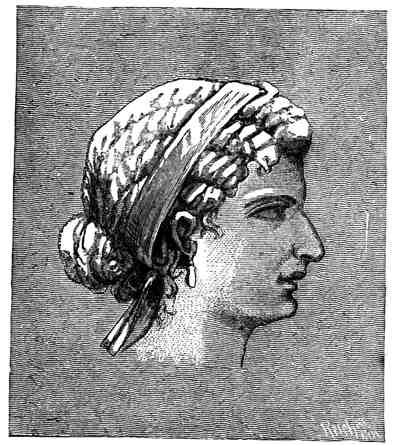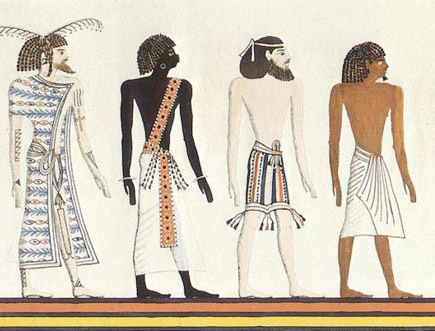 The anti-Semitic Zionists and Globalists who control our media are allowing people to promote ideas which are creating a false world view of history. This rewriting of history is also known as revisionism. Revisionism occurs because of poorly constructed research which is released to create political pressure and change on current ideologies.
The anti-Semitic Zionists and Globalists who control our media are allowing people to promote ideas which are creating a false world view of history. This rewriting of history is also known as revisionism. Revisionism occurs because of poorly constructed research which is released to create political pressure and change on current ideologies.
An example of revisionism, which has been questioned many times over the past two decades is the concept of Afrocentrism. This definition being a rewriting of history from the perspective of African culture and celebrating African achievements. Due to the strong race politics, especially in the United States, articles on Afrocentrism are considered factually accurate even though they are based on little more than a myth. Many scholars are not willing to contradict these blatantly false statements for fear of being labeled "racist" and their careers being destroyed. Political influence means that texts such as Black Athena are used in schools and colleges all across the United States perpetuating these thinly researched ideas as fact.
(Pictured right), Four individuals made by an Egyptian artist. As illustrated, the Egyptians clearly understood different racial groups. The first man on the far right is a light brown-skinned Egyptian. Some Egyptians were light-skinned like Europeans today, similar to the two caucasian men represented in the picture. The distinct black African negro represents the Nubians and other black Africans of that ancient Egyptian period. As you read through our articles, you will also see a number of blond-haired Egyptians depicted in drawings.
 Black Athena: The Afroasiatic Roots of Classical Civilization by Martin Bernal
Black Athena: The Afroasiatic Roots of Classical Civilization by Martin Bernal
From around 1975, Martin Gardiner Bernal underwent a radical shift in his interests. In his own words, he wrote: "The scattered Jewish components of my ancestry........"
Synopsis: Could Greek philosophy be rooted in Egyptian thought? Is it possible that the Pythagorean theory was conceived on the shores of the Nile and the Euphrates rather than in ancient Greece? Could it be that Western civilization was born on the so-called Dark Continent? For almost two centuries, Western scholars have given little credence to the possibility of such scenarios.
The brilliant book "Black Athena Revisited" is also worth noting. Made up of 20 essays from leading scholars who tackle and refute the claims made by Martin Bernal in Black Athena. The authors of these essays create a compelling argument showing that Bernal's claims are highly exaggerated and in many instances unjustified. We must challenge this revised history now, the consequence if we fail, will be our future generations will be taught to believe a completely different version of events. The media and world leaders do little to question or stop this revisionism amongst the African American populations.
In Black Athena, an audacious three-volume series that strikes at the heart of today's most heated culture wars, Martin Bernal challenges Eurocentric attitudes by calling into question two of the longest-established explanations for the origins of classical civilization. The Aryan Model, which is current today, claims that Greek culture arose as the result of the conquest from the north by Indo-European speakers, or "Aryans," of the native "pre-Hellenes." The Ancient Model, which was maintained in Classical Greece, held that the native population of Greece had initially been civilized by Egyptian and Phoenician colonists and that additional Near Eastern culture had been introduced to Greece by Greeks studying in Egypt and Southwest Asia. Moving beyond these prevailing models, Bernal proposes a Revised Ancient Model, which suggests that classical civilization, in fact, had deep roots in Afroasiatic cultures.
There are many critics against Afrocentrism and some of these critics are African-Americans themselves including Clarence E. Walker from the University of California, who described Afrocentrism as: "a mythology that is racist, reactionary, essentially therapeutic and is eurocentrism in black face."
Author Manning Marable who wrote Beyond Black and White: Transforming African-American Politics summarized it perfectly as: "Populist Afrocentrism was the perfect social theory for the upwardly mobile black petty bourgeoisie. It gave them a sense of ethnic superiority and cultural originality, without requiring the hard, critical study of historical realities. It provided a philosophical blueprint to avoid concrete struggle within the real world.... It was, in short, only the latest theoretical construct of a politics of racial identity, a world-view designed to discuss the world but never really to change it."
 Beyond Black and White: Rethinking Race in American Politics and Society by Manning Marable
Beyond Black and White: Rethinking Race in American Politics and Society by Manning Marable
Synopsis: A generation removed from the Civil Rights Movement and the Black Power explosion of the 1960s, the pursuit of racial equality and social justice for African-Americans seems more elusive than ever. The realities of contemporary black America capture the nature of the crisis: life expectancy for black males is now below retirement age; median black income is less than 60 percent that of whites; over 600,000 African-Americans are incarcerated in the US penal system; 23 percent of all black males between the ages of eighteen and 29 are either in jail, on probation or parole, or awaiting trial. At the same time, affirmative action programs and civil rights reforms are being challenged by white conservatism.
Confronted with a renascent right and the continuing burden of grotesque inequality, Manning Marable argues that the black struggle must move beyond previous strategies for social change. The politics of black nationalism, which advocates the building of separate black institutions, is an insufficient response. The politics of integration, characterized by traditional middle-class organizations like the NAACP and Urban League, seeks only representation without genuine power. Instead, a transformationist approach is required, one that can embrace the unique cultural identity of African-Americans while restructuring power and privilege in American society. Only a strategy of radical democracy can ultimately deconstruct race as a social force.
Afrocentric Myths
Examples of the myths promoted in Afrocentrism include the concept of Africans starting the Chinese, Indian and Egyptian civilizations promoted in the book "Out of Africa." This theory states all humans originally came from Africa and we are all genetically traced back to Mitochondrial Eve – the mother of all humans. If one believes we are all inherently the same, why is it that forensic examiners can racially profile human bodies based on skeletal remains? Archaeologists have been researching and uncovering human history for a long time and yet there is little evidence of African remains found in ancient Europe and Asian archaeological sites - how can this evidence be dismissed?
The idea that Africa and African civilization was the foundation in some powerful ancient nations; such as Egypt and Greece has been unfounded. One book which was written called "Not Out of Africa," uses evidence-based research to refute the politically motivated claims of Afrocentrism in Black Athena.
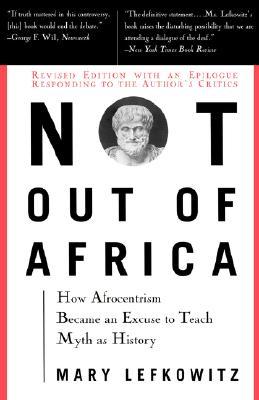 Not Out Of Africa: How "Afrocentrism" Became An Excuse To Teach Myth As History
Not Out Of Africa: How "Afrocentrism" Became An Excuse To Teach Myth As History
Synopsis: Not Out of Africa has sparked widespread debate over the teaching of revisionist history in schools and colleges. Was Socrates black? Did Aristotle steal his ideas from the library in Alexandria? Do we owe the underlying tenets of our democratic civilization to the Africans? Mary Lefkowitz explains why politically motivated histories of the ancient world are being written and shows how Afrocentrist claims blatantly contradict the historical evidence. Not Out of Africa is an important book that protects and argues for the necessity of historical truths and standards in cultural education.For this new paperback edition, Mary Lefkowitz has written an epilogue in which she responds to her critics and offers topics for further discussion. She has also added supplementary notes, a bibliography with suggestions for further reading, and a glossary of names
Another example of revisionism that is not stamped out is the belief that some African Americans are descendants of the Israeli tribes of Israel. They believe that black Jews were created from the "Curse of Ham" from the Book of Genesis where Ham cursed Canaan for looking upon his naked body and the curse turned his skin black. Considering that daily bathing and modesty are relatively new concepts and instead most people in ancient history swam naked in rivers or the ocean clearly in view of others, surely if the Curse of Ham was actually true, we would all be black today!
Genetic evidence has proven that approximately 80% of Jews are actually European in origin which further debunks this idea that there are African American are descendants of Jews.
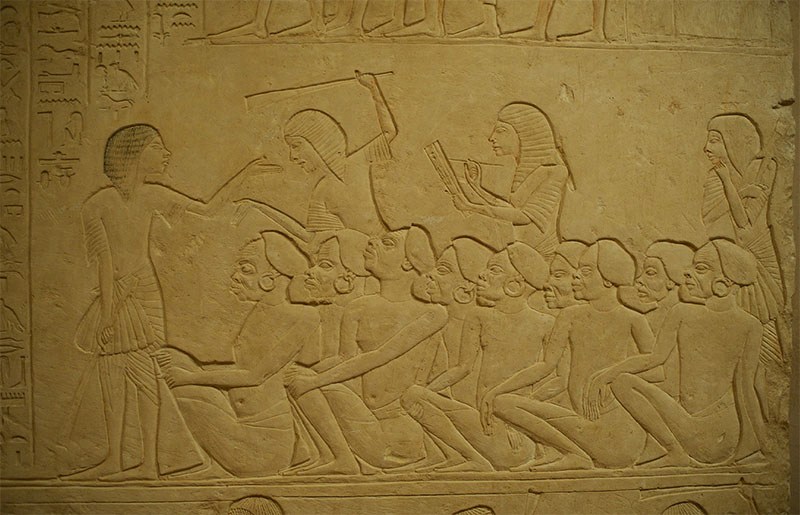 The Egyptians accurately recorded through their prolific artworks which clearly displayed the difference between themselves and black Africans. Also, their information reveals that there was the conflict between the two groups.
The Egyptians accurately recorded through their prolific artworks which clearly displayed the difference between themselves and black Africans. Also, their information reveals that there was the conflict between the two groups.
Black History Myth: Cleopatra
The basis for the claim that Cleopatra was black, according to black power websites, is because Egypt is located in the continent of Africa. The Chicago Church that Barack Obama belongs to, teaches that Cleopatra was black. Even “mainstream” black publications pander to this “black power” absurdity.
The ancient Egyptians are classified by anthropologists as “North African Caucasoid.” However, Cleopatra was not even Egyptian. An aristocracy of Macedonian Greeks ruled Egypt at the time and Cleopatra’s ethnic background as a Macedonian Greek is well documented.
Contemporary depictions of Cleopatra, from the time she ruled Egypt, still exists today. In these ancient Hellenic busts, we can see exactly what Cleopatra looked like in right picture.
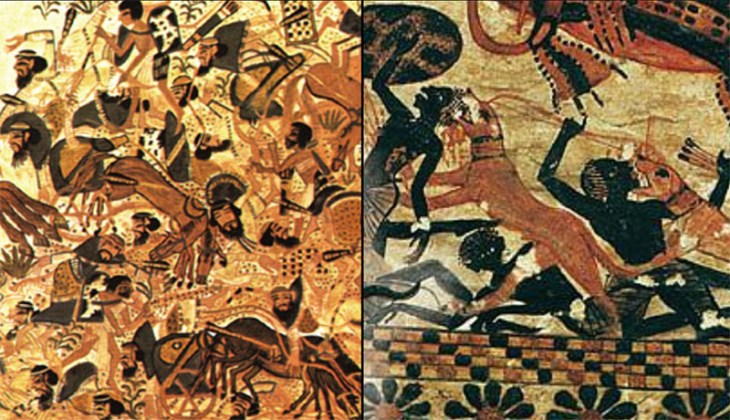
Above: Close-ups of the sides of Tutankhamen’s “Hope Chest” showing Semitic and black enemies being defeated. From The Children of Ra.
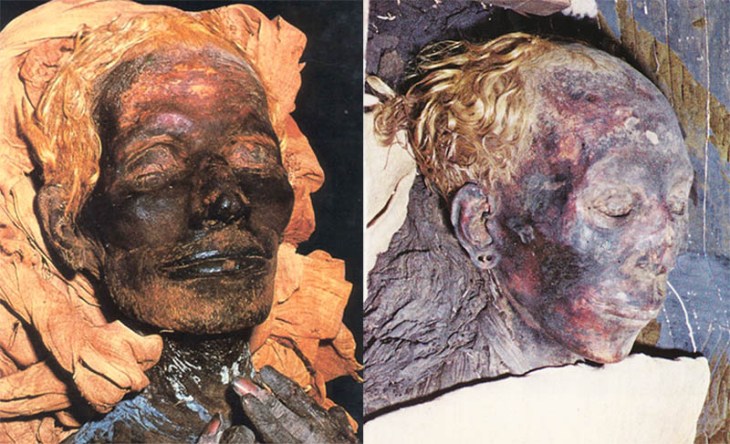
Above left: Yuya, an Egyptian nobleman from 1400 BC. He was the father of Tiy, the wife of Pharaoh Amenhotep III. Yuya’s blond hair has been well preserved by the embalming process. Alongside, his equally blonde-haired wife, Thuya, great grandmother of Tutankhamen. From The Children of Ra.
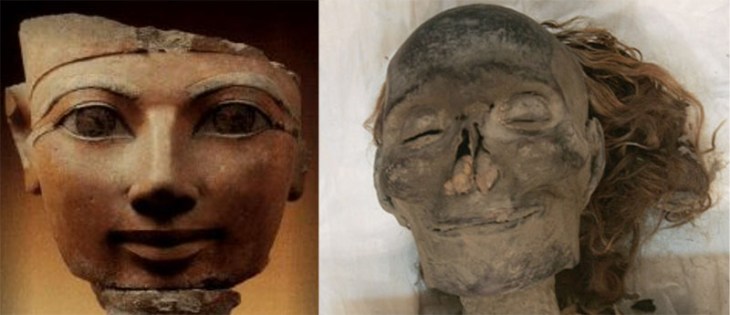
Above: A bust of the female Pharaoh Hatshepsut, fifth pharaoh of the eighteenth dynasty (1509–1458 BC), and her mummy. From The Children of Ra.
All shades of hair were found around the time of Ancient Egypt’s civilization – from brown to blonde, and even auburn and red. Today, these hair colors are found among the people of North Europe and North America, and are indicative of Caucasian origins. Does this mean there were fair-skinned, blonde or red-haired ancient Egyptians prior and during Egypt’s dynastic periods?
Ancient Egyptian Mummies Found With RED & BLONDE Hair
Cleopatra was of Greek ancestry so she was white and so was most of her relatives
Egyptian History
This lecture examines a key period of Egyptian history, which is roughly contemporaneous with the Babylon of Hammurabi, during which Egypt for the first time expands its horizons beyond its own frontiers.
The Middle Kingdom (Lecture 6)
Egypt's monarchy comes to play the dominant role in the Near East until the empire comes to an end with attacks associated with the so-called "Sea Peoples"—invaders coming out of both Libya and the Aegean world.
The Egyptians today are mainly Caucasian and Arab. The Ancient Egyptians were mainly Caucasian.
Africans Don't Need to Revise History – They Have A Wonderfully Rich Cultural History Already
Africans today should learn their true history and not start adopting false history in an effort to claim other people's culture and history. There are many great tribes such as the Zulus in South Africa and the Masai in Kenya who have a rich culture and interesting history from which Africans can learn.
The word Negro means black in Spanish. The word Africa came from Tunisia which was a Roman controlled area on the Mediterranean Coast and eventually the name Africa was given to the entire continent.
 Not all people who live in Africa are Negroes, for example, the Tunisians and Algerians are mainly Caucasian people and 99% of the population is classified ethnically
Not all people who live in Africa are Negroes, for example, the Tunisians and Algerians are mainly Caucasian people and 99% of the population is classified ethnically 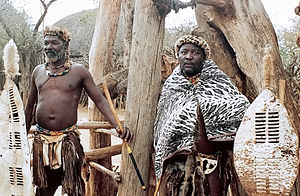 as Arab-Berber so they are called Caucasian Africans. They have been living in these areas all along North of the Sahara desert for many thousands of years.
as Arab-Berber so they are called Caucasian Africans. They have been living in these areas all along North of the Sahara desert for many thousands of years.
Useful Videos & Links
“Thousands” of Blond and Red-Haired Mummies Found in Egypt
Ancient Egyptians were not Black, Stop Robbing our History, Leave Egypt to the Egyptians
Ancient Egypt
Egypt's Golden Empire - The Warrior Pharaohs
Minoan Civilisation DNA Evidence
Mysterious Minoans Were European, DNA Finds
Minoan civilization was made in Europe
Half of European men share King Tut's DNA
Ancient White Egypt: March of the Titans Proven Right
Images courtesy of New Observer Online, Wikipedia and Story Nory
T



